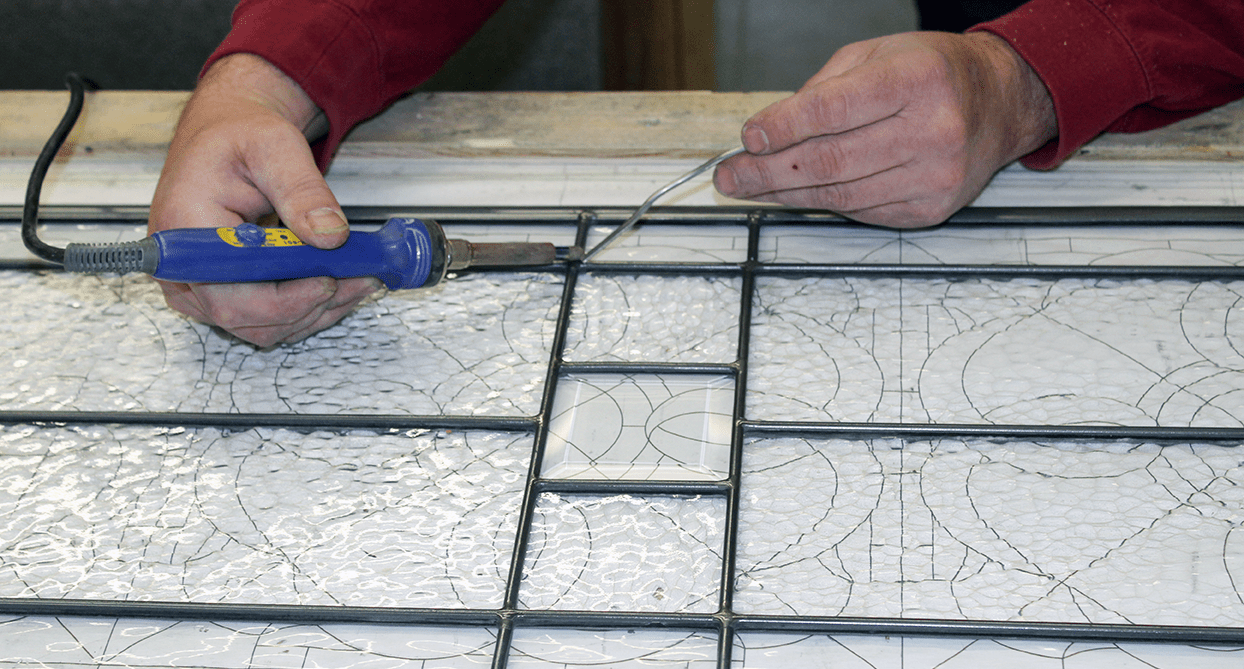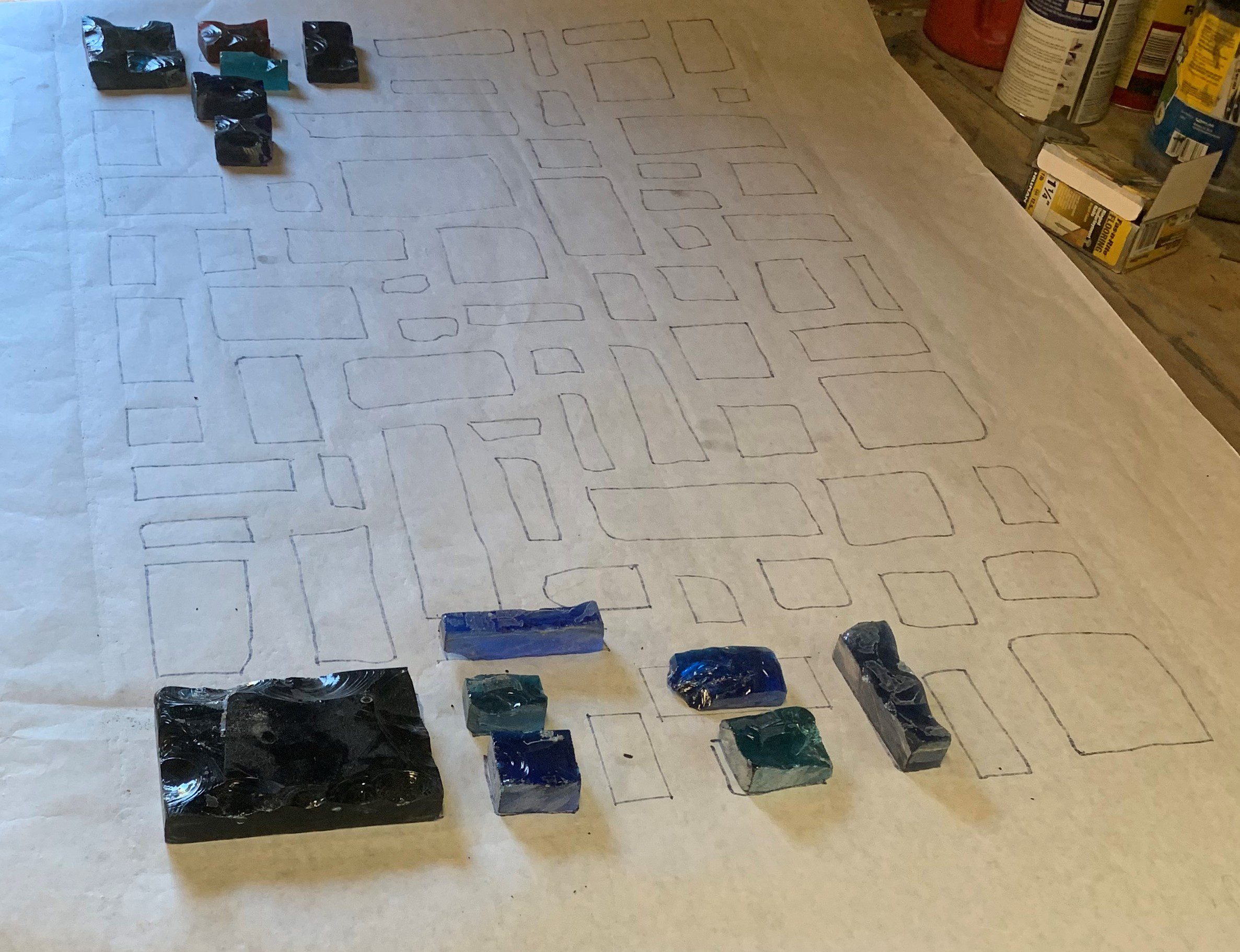

Dalle de Verre Glass Restoration
Dalle de verre glass, also known as faceted glass or slab glass, is a specialty glass art technique. This French term translates to “glass slab,” and it originated in Paris in the 1930s. Developed by Jean Gaudin, this process uses a colored glass that’s set in a matrix of proprietary epoxy. The thick glass slabs are either broken or sawed into the desired shapes and forms. The glass is then hammered on the edges to create a unique chipped look in order to better reflect natural sunlight. These glass pieces are added to a box of sand where the epoxy is poured and allowed to dry for at least 24 hours. Once dried, the glass is polished, and the resulting mosaic is either hung or installed in a window frame.
Dalle de verre glass is usually one inch thick, offering a significant depth of color that’s only achieved with this glass art technique. The sparkly and luminous look from the chipped edges creates an illuminating effect, especially when contrasted by the dark epoxy background.

The Challenges of Dalle de Verre Glass
While dalle de verre is known for its beauty and unique sparkle, churches have to decide if this stunning effect is worth the challenges associated with this type of glass. In terms of longevity and cost, dalle de verre is more than double the cost of leaded stained glass windows and has a significantly lower lifespan. The average product life of dalle de verre is around 40-50 years under the right conditions, while regular stained glass can last over 100 years.
Contributing Factors for Dalle de Verre Restoration
- Hail damage: This is the most common cause of damage in dalle de verre. Since the glass is so thick, it does require large hail in order to sustain damage.
- Heat damage: Dalle de verre is meant to be installed in direct sunlight in order to really capture that unique sparkle. This, however, exposes it to heat damage. Since the epoxy used is usually a darker color and the glass is usually darker as well, both are great at absorbing the sun’s heat. With overexposure to heat, the epoxy expands and contracts at a different rate than the rest of the glass. Spaces around the edge can form while the epoxy cracks from expanding and contracting.
- Plexiglas installation: A common remedy that church members try is installing Plexiglas over their dalle de verre to protect it. Unfortunately, this has the opposite effect; heat is then trapped in between the Plexiglas and dalle de verre, causing rapid damage and deterioration.
- Settling of buildings: Dalle de verre is often installed in new churches. When these new properties begin to settle, glass that has been installed too tightly will cause the epoxy to crack.
- Improper epoxy mix: When dalle de verre is produced, there are some instances where the resin and hardening agent are incorrectly mixed. This creates an unstable epoxy, which can lead to accelerated damage.
- Window rain damage: This is the rarest cause of damage, but it still can cause deterioration in dalle de verre. When water penetrates around the edges of the window, this can cause the epoxy to deteriorate. This is often due to improper bedding in the silicone.

Dalle de Verre Restoration Process
Dalle de verre has a much shorter lifespan than regular stained glass, requiring more frequent restoration. The process begins with removing the entire window and replacing it with a temporary one. We then take a rubbing of the glass in order to have a precise map of where each glass slab goes. Once the rubbing is completed, we have to take the entire piece apart by chiseling the epoxy. This is the most labor-intensive part of the process. We have to hand-chisel the epoxy while keeping all glass pieces intact. Even though there’s no lead cutting or glass restoration, the labor-intensive epoxy chiseling is the trade-off that makes restoration cost almost the same as a new dalle de verre window. When we’ve successfully removed all of the epoxy, all of the glass pieces are cleaned.
We then start from scratch by filling a box with sand and laying all the glass pieces out according to the rubbing we did. We pour our epoxy mix and let it set until it is completely dry. We polish all the glass pieces and return the dalle de verre back to its original location for installation.
Dalle de Verre vs. Stained Glass Restoration
When stained glass requires restoration, the entire window can be removed. When dalle de verre has a crack, it can’t be removed and replaced. The entire dalle de verre window will need to be replaced. Dalle de verre restoration is a very labor-intensive process, requiring a significantly higher financial commitment than regular stained glass restoration.
Work with the Dalle de Verre Restoration Experts
Church Stained Glass Restoration is honored to be the dalle de verre restoration experts serving the nation. We appreciate all glass art and are humbled to have the opportunity to restore such a unique glass medium that offers such a stunning look.
When it comes to restoration, it’s best not to wait. If you think that the dalle de verre windows in your church may require attention, we urge you to contact our office to schedule a consultation. Our team can restore your dalle de verre to its original beauty and preserve your treasured artwork.
